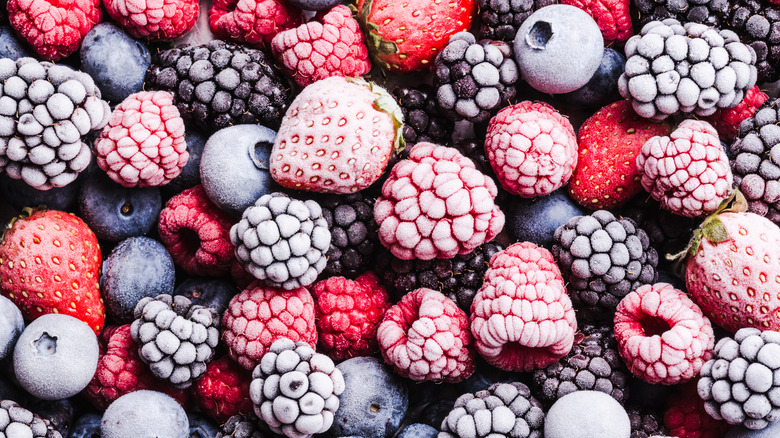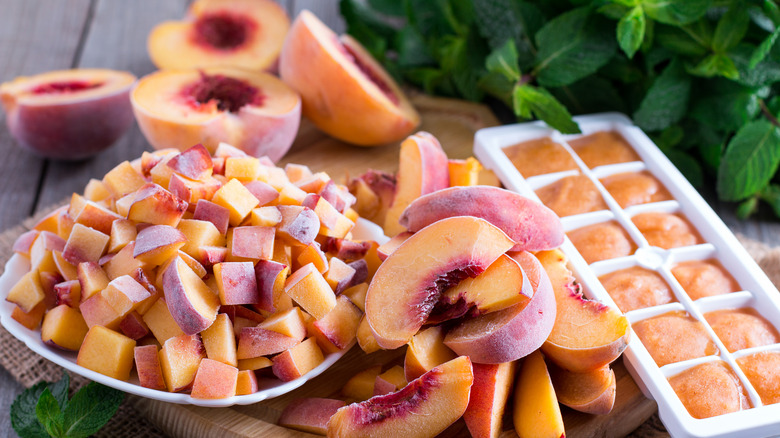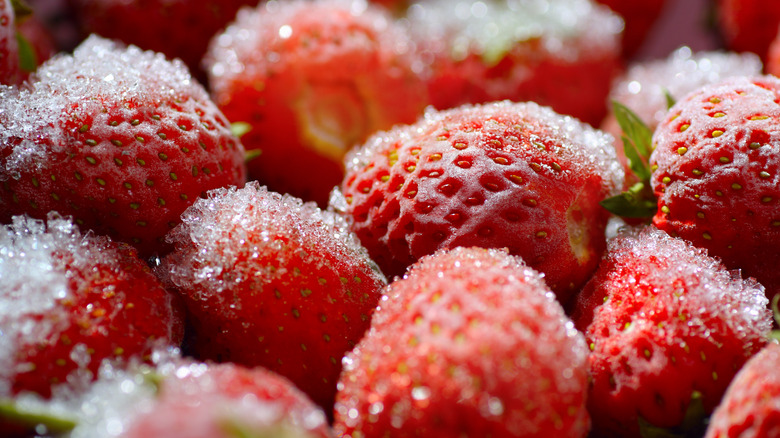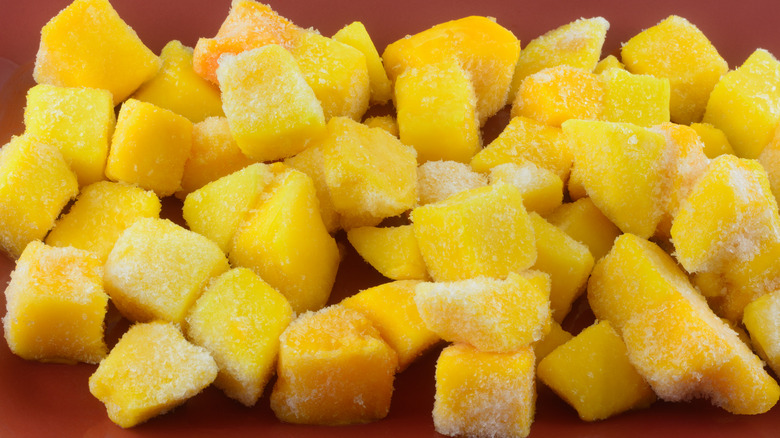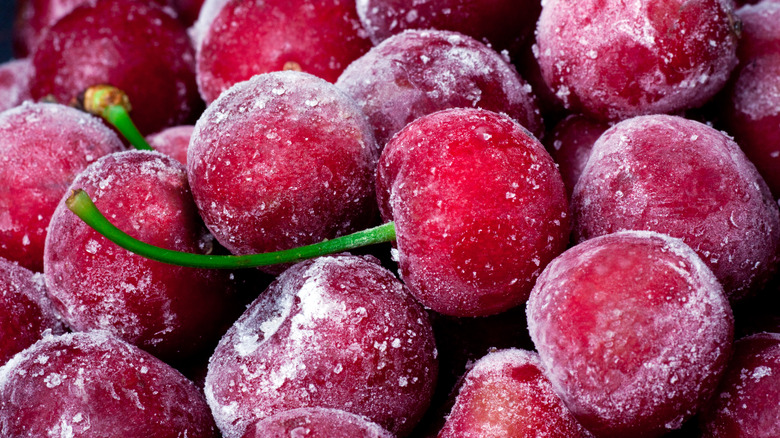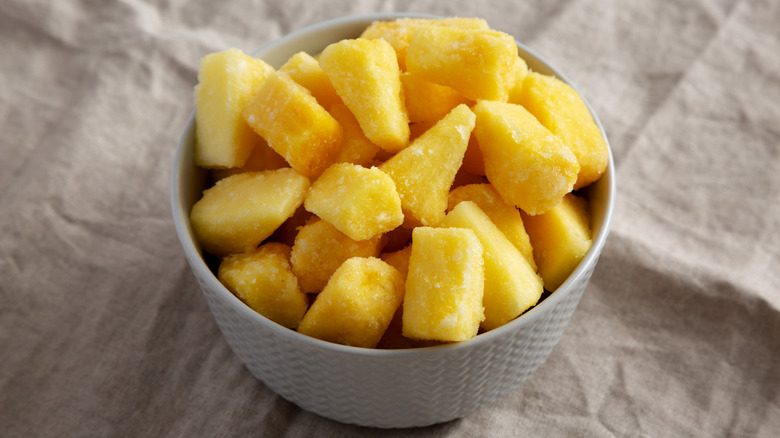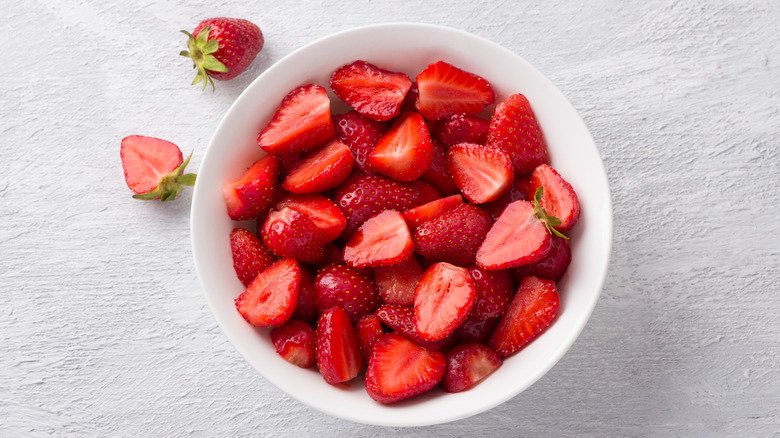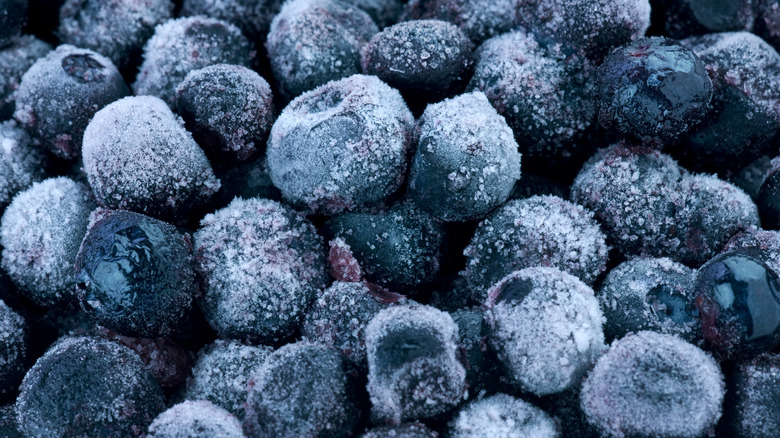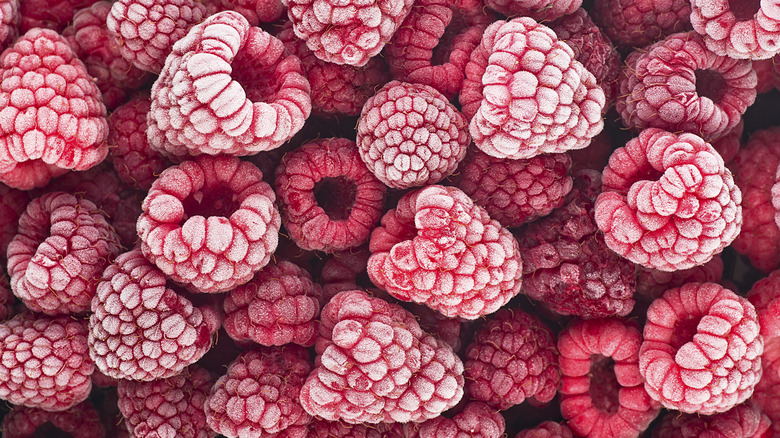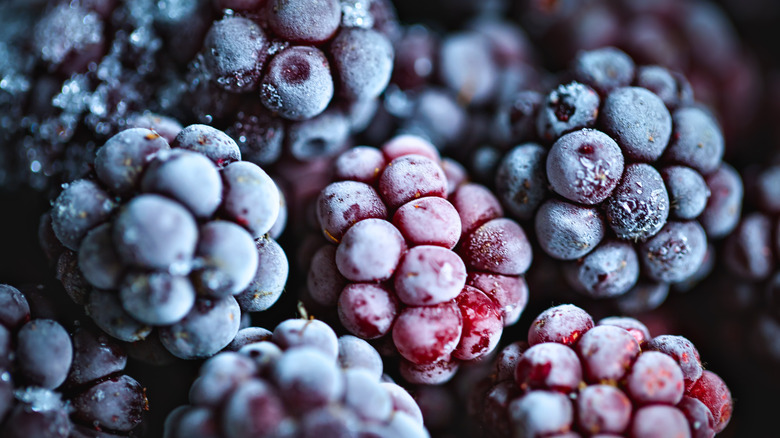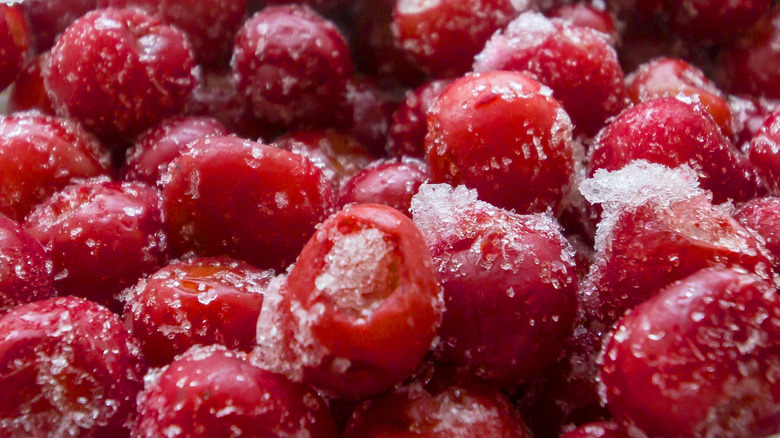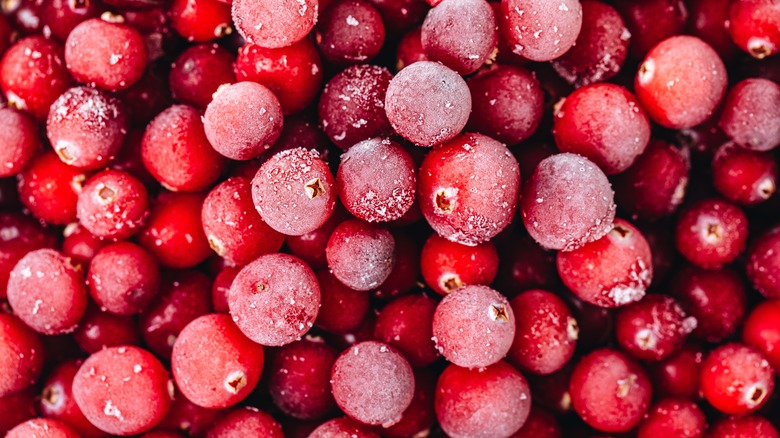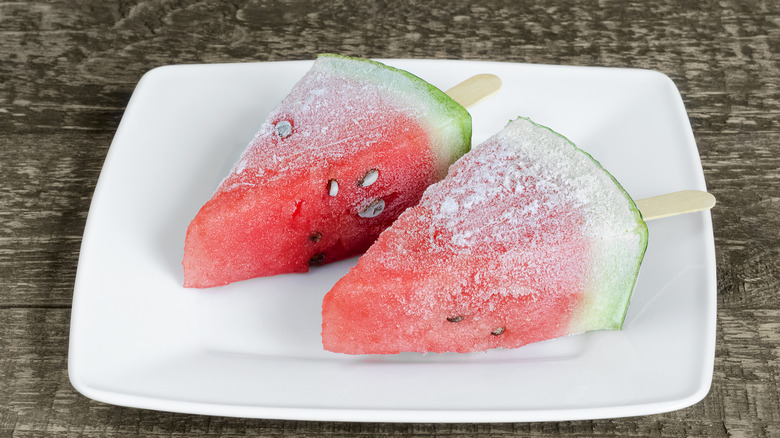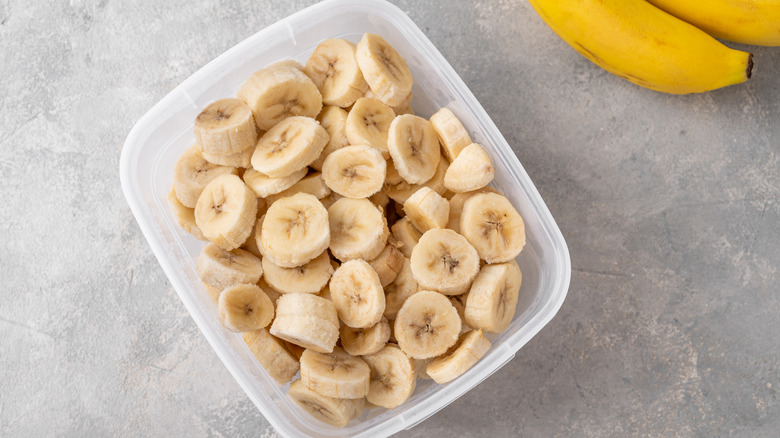The Best Frozen Fruits To Buy (And How To Use Them)
You wonder which frozen fruits are worth buying as you peruse bags of Dole strawberries, sliced peaches, and pineapple chunks in your grocer's freezer section. You want to eat more fruit, and a home freezer stocked with produce is a great step in that direction. You don't know where to start, though. You want to know which kind of fruit to pick and how to use it when you get home.
First, get enthusiastic about frozen fruit because it's healthy and practical. In 2015, University of California, Davis researchers shared findings that frozen strawberries and blueberries contained nearly identical nutrients compared to their fresh counterparts. The chilly method of preservation also makes seasonal and delicate fruits widely available year-round. Finally, consuming frozen produce reduces food waste since you can eat just a portion without worrying about the rest spoiling — that's handy if you're only cooking for one.
You'll find plenty of ways to use a bag of frozen fruit. When baking, frozen berries maintain their shape as you mix them into the batter, whereas fresh ones tend to disintegrate (imagine making raspberry muffins, for example). Some frozen fruits are easier to dip in chocolate. You'll need frozen fruit to make a range of chilled beverages like smoothies, mocktails, cocktails, and lassi since you simply won't get the same texture or temperature otherwise. Finally, nothing is as refreshing as a bowl of nearly thawed frozen fruit with a dollop of whipped cream when temperatures are soaring outside.
Frozen sliced peaches
Buying frozen sliced peaches is one of the best choices you can make because fresh ones can be complicated. You can only find the best delicious, juicy orbs for a few weeks a year at your local farmers' market, but these can also bruise easily. You have to eat them almost immediately. The fuzzy fruits from the grocery store produce aisle don't always taste so great, since producers pick them green to ship them over vast distances and leave them in cold storage. So, if local peaches are out of season, and you don't like the grainy, tasteless things at the supermarket, frozen peaches may fulfill your peachy needs.
Fortunately, frozen peaches aren't expensive. A one-pound bag of Walmart's Great Value peach slices costs less than $3 while Meijer's store brand goes for around $4. Fresh are cheaper — around $2.40 per pound from Walmart at the right time of year — but not enough to make a big difference when you add up the cost of all your groceries.
Blend frozen peaches with bananas and strawberries to make delicious smoothies. They're also fantastic for baking — include them in a peach pie, cobbler, or crisp. You won't have to peel or chop them and there's no need to thaw them first, either. That's pretty easy.
Whole strawberries
Making industrial frozen strawberries is labor-intensive, but more efficient than marketing the berries fresh. Workers must pick the juicy heart-shaped fruits by hand. As they pluck the ripe strawberries from the bushes, they use a special piece of equipment to slice off the green tops before placing ruby-colored fruit in a bucket or box. Soon after, that box is dumped on a conveyor which carries the berries through a water bath to clean them. Then, they're frozen and sorted into the pouches you pick up from the grocery store.
Farms with the equipment to freeze strawberries have a huge advantage because berries have a short shelf life. Freezing means monetizing the whole crop and losing nothing to spoilage. That might explain why frozen strawberries are cheaper than fresh. For example, you can buy a pound frozen at Walmart for around $2.25 while the same amount fresh costs about $3.30.
Frozen strawberries taste great by themselves as long as you don't let them thaw completely. Leave a few frost crystals and the texture's perfect, but otherwise, it'll get too mushy. You can use this fruit to make a sauce for strawberry shortcake or cheesecake. These frozen berries also make a great pie filling. The most fun recipes for frozen strawberries, though, are things like frozen strawberry daiquiris or strawberry wine slushies.
Mango chunks
Mangoes have a special flavor. One bite, and you're transported to a tropical beach, lying on a towel, under the beating sun. There's no limit to the amount of this fruit you'll want to eat, but it's not always easy to find a good one. Then, there's the unfortunate difficulty of cutting the flesh off the seed. Buying frozen mango chunks is one way you can simply bypass the gooey hands and slippery seed. The processed fruit is about twice as expensive as fresh — a pound of frozen mango chunks costs about $3.30 in contrast to around $1.50 per pound for a pound of fresh mangoes. Remember that you'll be throwing away about half the weight of the fresh mango, though, once you've removed the skin and seed.
Try your hand at making mango lassi with the frozen yellow cubes. This traditional Indian smoothie is deliciously refreshing on a hot day. You could make it with fresh mango, but why bother when frozen mango is already in chunks, and will add some extra chill.
Dark sweet cherries
Dark sweet cherries are one of life's true pleasures. There's nothing like sitting around outside with friends and a couple of pounds of cherries, popping them into your mouth, and spitting out the seed straight onto the ground. This modus operandi may not be for polite company, but it's deeply satisfying.
Of course, you may want to get sweet cherries when they're out of season and have to buy them frozen. Don't worry — these are fantastic too, but they are best for cooking especially since you won't have to pit them. They make a wonderful cherry upside-down cake, for example. This ingredient also takes the spotlight in spicy cherry chutney which tastes wonderful spread on bread or along with pork. Finally, you could use them to make brandied cherries — now, that's a dessert that will warm you up once the weather gets cold! Best of all, frozen dark sweet cherries are cheaper than fresh. A pound pouch costs nearly $4, but fresh the price tag is closer to $5. Still, get them fresh when you can, especially when frozen cherries won't work in your recipes.
Pineapple chunks
Pineapple is a blessing however you eat it — fresh, canned, dried, and even frozen. The prep work involved with fresh pineapple is exhausting — you have to cut off the prickly outside and then the hard inner core. By the time you're done, it feels like you've removed more fruit than you get to eat. Of course, that's where buying it from the frozen foods aisle in a pouch has the advantage.
Fresh pineapples can weigh around two pounds and cost about $2.25. A pouch of frozen pineapple chunks is closer to $2.50. That's half the weight for about the same price, but consider how much of the fresh pineapple you have to toss into the compost pile — the green leaves at the top, the prickly outside part, and the core. The price of frozen pineapple ends up looking pretty attractive.
If you're not sure what to do with frozen pineapple, try blending it with mango, banana, and coconut milk to make a refreshing tropical smoothie in the morning. After work, mix up some piña coladas to relax. You can even pour a few for your kids because this recipe doesn't call for any alcohol.
Sliced strawberries
Once a whole strawberry is frozen, it's difficult to slice or chop it. That means that if your recipe requires sliced strawberries, either you need to use fresh strawberries and go through the tedious job of slicing them one by one, or purchase a bag of pre-sliced frozen strawberries. The second option seems a lot easier. It's also cheaper — a pound of fresh strawberries costs around $3.30, while sliced and frozen go for $2.50. Be aware that many brands of frozen sliced strawberries also have sugar added, so make sure you know what you're buying and whether it will work in your recipe. Walmart's brand, Great Value, sells 64-ounce bags of frozen strawberry slices with no sugar or corn syrup added — the ingredient label only lists strawberries.
You'll find that sliced, frozen strawberries are perfect for creating the filling between two layers of cake. First, you spread whipped cream or mousse, and then lay the sliced strawberries over it. Sliced strawberries are also fantastic for decorating open-top strawberry Jell-O pies. If you use frozen, they'll help the Jell-O set up faster. They also go great in a tangy strawberry rhubarb pie. Finally, sliced strawberries are easier on your blender for making smoothies.
Blueberries
Picking blueberries straight from the bush and then popping them into your mouth is an unrivaled experience. If you pick more than you need, though, you should wash them, pat them dry, and freeze them to use later in smoothies. Not everyone has the time to visit a blueberry farm or lives someplace near one. If that's the case, you probably get more disappointing blueberries in a plastic tub at the grocery store. They sometimes cost almost $6.25 for just over a pound. If that seems expensive, try the industrially frozen pouch. You'll get a pound for less than half the price.
You won't want to just pop frozen blueberries into your mouth, though. When frozen, it's hard to enjoy their full taste, and the temperature might bother your teeth. They get mushy when fully thawed, as well. Half-thawed, they're a delicious addition to fruit salad. Mix them straight from the freezer with sugar on the stovetop for just a few minutes to make a blueberry sauce for ice cream. You can also easily incorporate them in recipes like blueberry muffins or pancakes. Since they're hard, they'll be easier to mix into the batter without smashing.
Raspberries
There's no other fruit that embodies the combination of tart and sweet quite the way raspberries do. If you've ever taken care of thorny, unruly raspberry bushes and tried to pick some of the berries, you'll understand why a 12-ounce tray at the grocery store costs about $6. The flesh of these berries is so soft, that they become mush under the slightest pressure. Farmers and supermarkets alike have to take extra precautions when transporting and shelving raspberries.
Freezing them, on the other hand, is much easier. Producers, like Rushmore Essentials from California, must do this onsite, just after picking the berries. The 500-hectare farm picks and freezes several types of delicate berries — strawberries, blueberries, blackberries, and red currants in addition to raspberries. Once frozen, raspberries are harder, and easier to put in a pouch and transport. They also have a much longer shelf-life. That means they cost less — about $4.25 for 12 ounces.
The most fun way to use frozen raspberries is to space them out on a cookie sheet and pour chocolate shell topping over each one. You'll create little chocolate spheres filled with raspberry goodness. Of course, raspberries also taste fantastic over ice cream and mixed into smoothies. You could even make a raspberry sauce for cheesecake.
Blackberries
Blackberries are a little harder and tarter than raspberries. Fresh, on their own, they aren't the most delicious fruit. You may enjoy them more when they're frozen. Then, you can use them in any number of recipes. Try them in blackberry cobbler, for example. They make a wonderful pie, as well — you could mix them with other fruits to add shades of flavor. You might even want to substitute them for cranberries in these cranberry crumble bars. You could also make blackberry sauce for your waffles.
Fresh blackberries cost around $4.80 for a 12-ounce tray, while a 16-ounce pouch of frozen is $4.25. That means frozen blackberries are cheaper than fresh, but still more expensive than most other frozen fruits. In other words, if you have limited space in your freezer or a limited budget for frozen fruit, pick something other than blackberries. The taste-to-price ratio just doesn't justify making an extra effort for this fruit.
Tart red cherries
If you ever tried eating a tart cherry on its own, you probably spit it out. On the other hand, you probably love cherry pie, jam, and cheesecake. Once you've cooked this fruit and mixed it with sugar, the taste transforms into something addictive. Grocery stores rarely stock fresh sour cherries, though, so you'll need to look in the canned goods or frozen food aisles.
You may have bought canned sour cherries before to use as pie filling. They usually taste good this way, but if you want more control over your pie filling, try frozen. A 21-ounce can of cherry pie filling costs a little more than $3. Unfortunately, this product usually contains food coloring and added sugar. A 12-ounce pouch of frozen tart cherries goes for almost $4.70. That's more expensive, but you get to choose how much sugar to add while also skipping the food coloring.
Cranberries
You can only get fresh cranberries around Thanksgiving when stores start stocking bags of Ocean Spray cranberries. If you love cranberries, buy more than you need, stick them directly in the freezer and you'll have frozen cranberries throughout the year. Each bag will cost between $3 and $4. If you didn't think to buy in bulk in November, you can purchase slightly more expensive pre-frozen cranberries all year. For example, you'll find the Cape Cod Select brand at Meijer for around $4.30 per pound.
Using frozen cranberries is about the same as using them fresh. You can make all the same dishes — cranberry muffins, cranberry sauce, and cranberry bread. If you've only tried canned cranberry sauce before, you're in for a pleasant surprise when you use some frozen cranberries to make homemade sauce. It's very simple, you just need a little water, some cranberries, and a lot of sugar. The final product is so good you'll want to eat it with a spoon by itself.
Watermelon
In the middle of winter, you may daydream of warm summer evenings spent eating watermelon in your backyard. You may not be able to sit out in the snow, but you can enjoy watermelon all year, especially if you buy it frozen. Bite-size, frozen cubes of melon, nearly thawed with just a few ice crystals for crunch are delicious. Even better though, blend them up to make a watermelon slushie and mix it with lemonade. You could even use frozen watermelon chunks instead of ice to cool drinks. The possibilities are endless, but if you don't mind making something more elaborate, try this recipe for watermelon sorbet.
A 12-ounce pouch costs around $4 — that's $.33 per ounce. A personal-sized watermelon costs about the same amount, but weighs more. Of course, you reduce the weight when you cut off the rind. It also takes a lot of effort. On the other hand, if you're a huge fan of frozen watermelon, you could buy several large ones on sale and chop them into bite-size pieces. Then put them in the freezer on a cookie sheet. When they're frozen, save them in freezer bags and use them when you need them.
Bananas
Frozen bananas are glorious for making smoothies and silky banana bread. When you mash fresh bananas by hand, they get goopy in places and have chunks in others. Alternatively, if you freeze them, and then thaw them, they end up with the texture of goo. That thick liquid is perfect for incorporating into any type of cake, bread, muffin, or cupcake batter.
Bananas are one of the cheapest fruits you can buy — a pound costs around $.70. The biggest problem with frozen sliced bananas is the price which is about $2.60 per pound. That's nearly five times more expensive than fresh. So, if you're a big fan of frozen banana slices, buy the fruit fresh, and freeze it yourself. Best of all, bananas are a low-effort fruit — peeling them is easy, and slicing them requires almost no pressure. It won't take you long to fill up a few freezer baggies.
